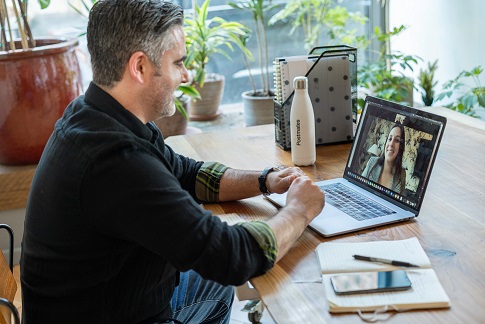You may be trying to reach an agreement in a family law matter, and wondering about the options available for resolving the issue. One option that has become increasingly popular in recent times is online and video mediation.
Online and video mediation allows parties to participate in mediation remotely, using technology such as Zoom or Microsoft Teams. This can be a convenient and cost-effective way to resolve disputes, as it eliminates the need for in-person meetings and travel.
Many people have become more familiar with online video technology during the global pandemic when many parents were working from home, and children were learning from home.
Mediation in person wasn’t possible during lockdowns, but that didn’t mean there weren’t still family law matters needing resolution. So, mediation (and Courts) moved online. Whilst some mediators struggled with the technology, most of us have adapted and now that we are no longer in lockdown, embrace it as another option for families.
The benefit of mediators and lawyers now being so familiar with Zoom and Teams, are that they are platforms that are free for you to use as a party to mediation.
We incorporate an element of video mediation into our mediation preparation sessions. We spend 2 hours with each party individually before the mediation. Sometimes it’s hard for people to get time off work to meet with us, so we schedule those meetings via Teams, which gives us more flexibility with the timing and is so much better than a phone call!
How do I prepare for online or video mediation?
When participating in online or video mediation, it is important to be prepared and to have a reliable internet connection. Make sure you have the strongest possible signal in your home or work. Video platforms consume quite a lot of bandwidth and weak Wi-Fi signals can result in video freezing, which is a stress you don’t need.
You will also need a device with a camera, such as a computer or a tablet, to participate in the video portion of the mediation. If you can use a computer on a desk with a webcam, that is definitely preferable to a phone. If you can only have your phone, consider if you can go to a friend or family member’s house and use their computer and webcam, or otherwise, make sure you have a stand for your phone, so it is not waving around (which can make the mediator feel a bit seasick!).
Make sure you do a test run of the video technology that will be used, before the mediation. Do a test Zoom or Teams meeting (it will be free) with you and another person to make sure you feel comfortable and that everything is working. Download anything necessary to make the programs work (remembering this will be free).
Check the room set up. Is the lighting ok? The mediator will need to clearly see your face to be able to function effectively (borrow your teenager’s selfie ring light if you need to!)
On the flip side, make sure there is not a window behind you creating glare that will blind the mediator. Check that during your test run with a friend as you won’t be able to tell from your end, and you don’t want to be spending mediation time, trying to adjust the blinds.
Check the sound. Make sure you know how to mute and unmute yourself. If possible, use headphones rather than a speaker as it reduces feedback when there are multiple participants
A word of warning: Be careful playing with filters, or you might turn yourself into a cat:
Will we be in the same room?
During online or video mediation, you will be able to communicate with the mediator and the other party in real time, just as you would in an in-person mediation. You will be able to discuss the issues and work towards a resolution, with the mediator helping to facilitate the conversation. Sometimes online and video mediation are conducted with everyone in the same virtual room, but often there will be individual breakout sessions where you will speak privately with the mediator in a separate room.
What if I need a break?
If you need a break, then you can ‘leave the room’ by simply turning off your camera and muting your microphone. You should not disconnect from the call unless the mediator asks you to. I recall one mediation where one party kept closing the lid of their laptop during a break, not realising this was disconnecting the call.
What if I want to leave?
It’s important to remember that just as in in-person mediation, online and video mediation is voluntary, and either party can choose to end the process at any time.
Online and video mediation can be less intimidating than in-person mediation. Some people may feel more comfortable participating in a mediation remotely, rather than meeting in person. If you are feeling uncomfortable being in the same ‘virtual room’, you can ask the mediator to move to private ‘rooms’.
What about confidentiality?
The same confidentiality rules apply for all types of mediation, regardless of the format, so any information shared during the mediation is kept confidential unless both parties agree to its disclosure.
It is very important that you have your computer set up in a private area where you cannot be overheard by anyone else – especially children. If you have young children at home, try to arrange for someone else to care for them away from your location if possible, or otherwise to occupy their time so they don’t disrupt you during the mediation or have you worried if they are ok. Detailed negotiations over parenting time or finances can be derailed if someone needs Mum to charge their iPad.
Scheduling advantages
One advantage of online and video mediation is that it allows for greater flexibility in scheduling. You can participate from the comfort of your own home or work, which can make it easier to fit mediation into busy schedules. It can be especially helpful for parties who live in different locations, as it eliminates the need for travel. Online and video mediation have made mediation far more accessible for rural and remote Australians* and those living with a disability.
(*subject to the limitations of the NBN…….)
Online and video mediation is not suitable for every case, and some matters may require in-person mediation. However, for many family law disputes, online and video mediation can be an effective and efficient way to resolve the issue.
Book a free discovery call to learn how we can help you reach an agreement through mediation.
Photo by LinkedIn Sales Solutions on Unsplash

